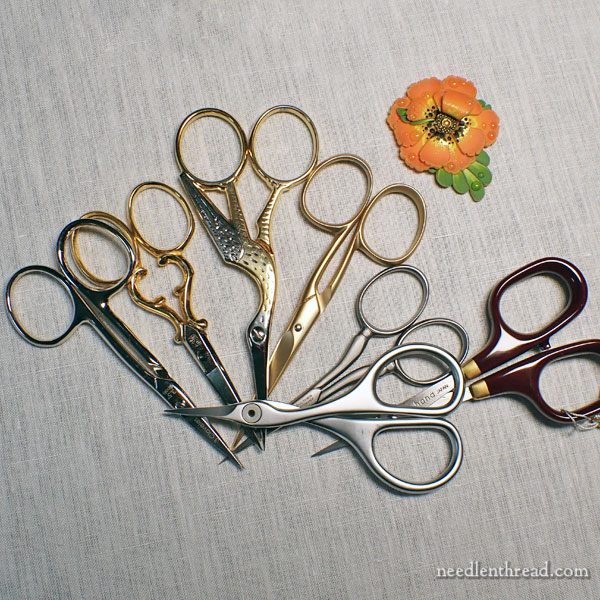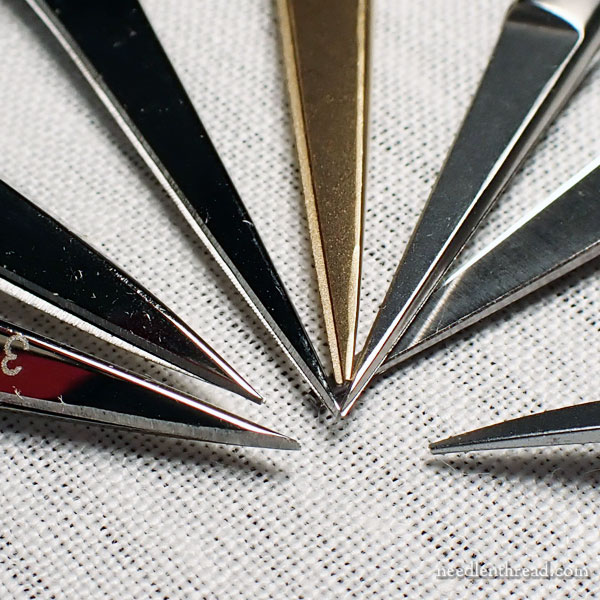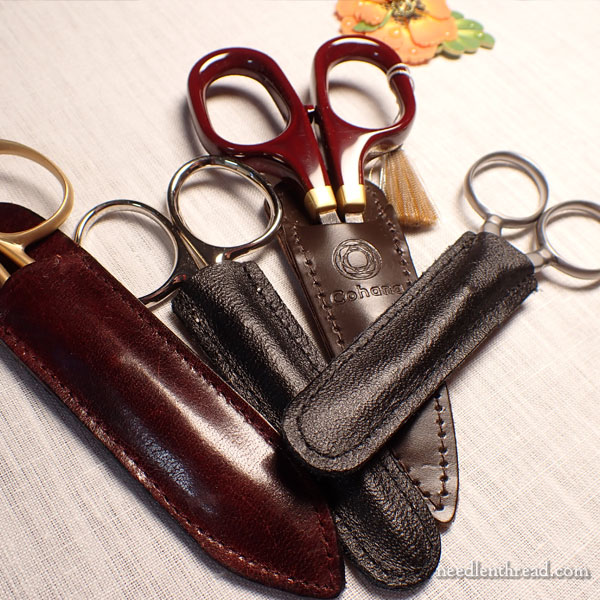Embroidery scissors! Nothing beats a Great Pair of Embroidery Scissors!
One thing that I’ve discovered over the years is that a great pair of embroidery scissors does not have to equate with a jaw-droopingly expensive pair of embroidery scissors.
In fact, I have it on very good authority that some of the most expensive embroidery scissors on the market today don’t hold a candle, mechanics & functionality-wise, to some of the comparatively moderate-to-lower-priced scissors that are available.
The measure of how good a pair of scissors is, then, doesn’t necessarily depend on the cost of the scissors.
That said, scissors that have a little more oversight and care in their design, production, and finishing are bound to be better scissors, and they often cost a little more than the blister-packet scissors you might pick up at a big-box store.
I’m going to venture a personal opinion (which isn’t unusually – I do it all the time), and it is this:
If you want a good pair of embroidery scissors, there’s more involved than just buying the scissors. Let me explain…

Scissors – good scissors – are an investment, whether you pay $20 for them, or $100 for them, or (choke) $500 for them.
Every single pair of scissors that I’ve bought in my life that I consider good scissors have been an investment.
The highest price I’ve paid for a pair of scissors was $120 for a pair of sewing shears. The lowest price I’ve paid for a pair of what turned out to be Really Good Scissors was about $15. And I’ve bought decent $8 scissors, too.
Regardless of the price tag, they’re an investment because 1. (the obvious) I paid hard-earned money for them; 2. They are good, and therefore, I want them to last, and therefore, I will invest care in them. So they get my time and attention.

Let’s talk about basic scissor care, and then I’ll mention my favorite way of ensuring the longevity of my scissors.
Some Scissor Attention Tips
You can care for your scissors a number of ways:
1. Use them for their purpose. Really good embroidery scissors should be reserved for cutting embroidery regular embroidery fibers and / or small snips of fabric. When it comes to non-regular embroidery threads – like metallics, real metal threads, beading threads (Fireline and the like) – use scissors specially designated for those tasks. Don’t use any of your embroidery scissors to cut paper, to slice open boxes, or any similar degrading use!
2. Keep your scissors in particular places (like a tool caddy or a tray) and not just flailing about, where they might end up loose in drawers or knocked off tables or banged about.
3. When they need it, have them sharpened and maintained by someone who knows how to do it and has a good reputation for it. This is only required as necessary for the scissors – if they become dull or the mechanics aren’t working like they used to. Don’t over-sharpen them. I’ve heard of people having their scissors sharpened faithfully once a year, but this is rarely necessary with a decent pair of scissors that are just used for cutting thread.
Finally, there’s this:
You’ve got the scissors, but…
Where’s the sheath?
4. Keep your scissors in a sheath.
A sheath is a protective sleeve that you can slide your scissors (or any blade, really – knives have sheaths, too) into, in order to protect them.

But it’s more than that!
Protection of the scissor tips and blades may be a sheath’s obvious and perhaps primary purpose, but it’s not its only purpose.
The sheath protects everything around the scissors, too.
Scissors, after all, are sharp. Drop of pair of embroidery scissors, unsheathed, into your embroidery project bag, and you risk damage not only to the scissors, but to the stuff in the bag and to the bag itself.
The sheath doesn’t have to be some fancy-schmancy thing. Sure, the higher the price of the scissors, if they come with a sheath, the more likely it’s going to be a nicer sheath of some sort. But I’m not picky when it comes to a sheath.
If it’s a plastic casing that fits over the blades, that’s ok! Leatherette, vinyl, synthetic something or other – it’s fine! Sufficient unto the scissors is the sheath thereof. As long as the sheath covers the blades, keeping them and everything around them in good condition, I’m happy.
If your scissors don’t have a sheath, you can always make your own, too. It’s really just two pieces of (something) sewn (or glued) together that will cover the scissor blades snuggly, without falling off.
Most needlework shops will have sheaths on hand for scissor purchases, or sheaths for sale. Sometimes, the sheath is swag for the shop, and when you make a scissor purchase, they include a sheath with the shop’s name on them. That’s great!
So, next time you’re in the market for a pair of embroidery scissors, don’t hesitate to ask, “Where’s the sheath?”
Got any tips for scissor care? We’d all love to hear ’em. Feel free to join the scissor chatter in the comment section here!







Knitting needle protectors can be used to protect the points of scissors. I use one when scissors are out on the table but used infrequenty and inside a simple felt sheath (which can be marked with initials to show the type of specialist scissors inside it (eg goldwork scissors).
Having punctured a project with loose shears in a bag before, I agree that scissors should be sheathed! A simple bit of cardboard folded over and taped will do. And since I live in a *really* humid climate I store my less used scissors in acid free cardboard sheathes and use my tighter fitting leather sheathes just for scissors I am using regularly. Leather traps moisture and not all steel is as stainless as I might like.
Almost impossible to find someone who sharpens scissors. Maybe in a very large city but not in a smaller town.
(I think that one can never have too many pairs of scissors!)
Thanks Mary, I have several pair of scissors and I use the rubber tips that come for knitting needles – they fit over the point of the scissors and protect the tip. I try to condense things when I carry on stitching on trips! This works great! thanks for you information Love your site and tell everyone
I love making a pretty little sheath for my needlework scissors. As I am frequently working on a few things at the same time this means scissors in every bag. You told us once every project should be ready to grab and go. Such a great idea. Now I am short of scissors sheaths. Must get going on this. Thank you for the reminder
I use the old fashioned cuticle scissors that belonged to my mother…I only use them for cutting thread…they are still sharp and work perfectly for me…I just happened to see them back in the day when trying to find the right scissors in my collection…could not be happier……….
I bought myself a really pretty little manicure kit specifically to have a pair of scissors I could take on airplanes. Of course, I haven’t been anywhere since Covid, but SOMEDAY I’ll be able to use the kit again!
Wendy, TSA allows scissors onboard aircraft as long as the blade (not the entire scissor) is 4″ or less from pivot to tip. And of course, sheaths are HIGHLY recommended. I bring my embroidery scissors (blade length 1.5″) in my carry-on for every trip (I fly monthly) and have never had a problem. I opt not to take my irreplaceable Dovo hardanger scissors, just in case (it’s always the TSA agent’s option regardless of the published rules).
I love the Fiskars scissors that you use your hand to cut instead of your fingers in a tight opening. I’ve been using them for years and got my mom a pair too cause of the arthritis. They come in many styles and I dedicate certain ones for certain jobs.
I ordered a spare curved premax to be kept in a secure location in the event of a natural disaster. Lol.
Love your blog. Recently, I purchased a small pair of scissors which I totally adore. They are tiny, really sharp, come with a sheath, and best of all serrated. In the neighborhood of $20.00. Made by Karen K Buckley who is a quilter.
Hi, Janet – Yes, I love these scissors! I use them for goldwork, and I also have a pair for regular threads. I’ll be carrying them in my online shop shortly. I’ve got a supply of them, but I’m waiting to list them when the next kits are launched. They’re great little scissors – affordable and really precise! … and I’m glad they finally come in a second color, so that I can easily distinguish the metal thread scissors from the regular thread scissors. 🙂
I adore the Karen K. Buckley micro serrated edge scissors. Most of my Crazy Quilting is on silk and these magical scissors trim the fabric precisely so it won’t shred on the edges. They work on silk ribbon too.
They are a necessary tool for raw edge applique’-perfect edges every time. For under $20 too!
Thanks for this great post. What sort of scissors would you recommend for cutting metallic and bending threads?
Hi, Del – since I’m working with metal threads these days, I’ll be writing about that very topic soon!
Worn out leather gloves are a good source of material for custom making scissor sheaths.
Some patterns for stitcher’s wallets, ‘huswifes’, trays, and/or basket liners, or caskets.
What a great idea!
Any recommendations for a good/lesser expensive pair of scissors ✂️ ?
Absolutely! I’ll be writing about my favorites in that category shortly!
I have a pair of fiskars embroidery scissors, I think I spent $9-$10 and they do just fine for me
Do not cut beeswax covered threads with serrated titanium embroidery scissors…..
Tilly, sounds like you might have a story behind that tip…?
I have a great tip for scissors (or hole punches) that seem to “bind” – double fold a bit of wax paper and cut a few snips or rub the blades with the wax paper if you really don’t want to cut it. This also works on hand and sewing machine needles. I keep bits of wax paper with all my sharp tools.
I’ve made scissors sheathes out of felt. I traced around a sheath to make a pattern and cut the pieces out of felt. Then stitched around the two pieces with one of my sewing machine embroidery stitches in a contrasting color thread. I’ve made them for embroidery group favors, too.
Good morning.
My Mum was a Tailor and in the workshop their scissors were sharpened every morning by running back and forth round the neck of a bottle. I use this method to keep my embroidery scissors top notch sharp. I have kept a small food essence bottle for the little scissor. Love your newsletter. Regards from New Zealand where we are blanketed in thick fog in the middle of our Winter.
I like the little rubber tip you can buy to use to protect the tips in case you drop them
In addition to a sheath, I think each scissors needs a good scissors weight/fob. Keeps the scissors from getting lost in the crevices of the couch or wherever you are stitching, and if they happen to fall, it keeps them from falling point first.
…and here I thought those things were purely decorative. I must now indulge myself!!
If you keep your scissors vertically in a caddy, make sure the bottom of the caddy is *well* padded. And check the padding occasionally. It’s a sad day when you go to use the scissors and find the tips have been damaged by hitting the bottom. And it might save glass or other more fragile holders from breakage by heavier sewing scissors or shears.
I have all sorts of scissors (not all are used), from vintage ones from Mom/Grandma or estate/garage sales to new. They range from kindergarten style to a pair of very sharp thin pointy scissors for Hardanger. All have their uses, even if only for decoration.
@Carol – I had no idea the fob kept the scissor from falling point first. I thought they were just for pretty and to tell them apart from other people’s scissors at group stitching sessions.
If there is no-one near you who can sharpen your scissors, learn to do it yourself! I learned how to sharpen my very good knives. The internet is a good source for instructional videos.
Give it a try! You will make yourself so happy!
Using the sheath can protect you. The one time I didn’t put the sheath on my embroidery scissors the points came through fabric of my tote and poked me in the leg through my pants. My parking spot was a distance from my condo and I looked like I’d been stabbed by the time I got in my house. Needless to say I’m a big fan of scissor sheaths!
Does anyone know what can be done about the tip on one blade of a pair of embroidery scissors that is missing? They still cut very well overall. The part that is missing is approximately 1/8″. They were a gift and I would like to get them fixed without investing a large amount of money.
Hi everybody! I like to tie an 8″ long piece of 1/4 ” satin ribbon onto one handle of my embroidery scissors. Makes them easier to find in my kit, and also if they accidently slip down the side of my chair. I change the colour of the ribbon to contrast with the predominant colour of my current project. Right now, I’m working in blues and purples, so the ribbon on my scissors is red with white polka dots. Jaunty!
I like a sheath that also has a cover to go over the handles too, no chance of them sliding out then wherever you happen to keep them when they’re not being used.
Hello All,
I have a precious pair of KAI scissors ( the Japanese make amazing blades!) and they reside in a little leather sheath. In fact most of my pairs of scissors have sheaths. I am a bookbinder so have plenty of leather scraps and a sheath is very easy to make. My scissors are attached to the sheath with a strong waxed cotton thread with a couple of charms for ‘pretty’. This way, they are ‘joined at the hip’ and it saves the search for the sheath when it is time to put them away.
Thanks for your always interesting newsletters. Your work is beautiful!
Paddy (Mrs) in South Africa
Paddy, that is such a great idea! I have to start attaching my covers to the handles! I tend to lose everything as I’m a bit disorganized, and this would keep them together!
I love that the Karen Kay Buckley scissors each come with their own plastic molded covering for the tips, but I have already lost most of them because I have a habit of leaving the scissors on a table while I’m working on a project (or two) and something else gets placed on top of it, or the cover gets knocked off the table and ends up in a random box under the table (a hazard of hoarder territory). Tip: I’ve found that the plastic hose used in aquariums works really well as a tip protector. It can be cut to length and after time, it conforms to the angle of the blades to keep it attached easier. It’s also available in varying widths to fit multiple sizes of scissors. Tip: it’s frequently used to form handbag handles that are fabric covered.
Yes, I love these scissors, too! I’m carrying them in my shop shortly – I’ve got a good supply of them, to list when my next kit launches. I have used them for goldwork thread cutting for years, but I also have a pair for regular threads. They’re wonderful little scissors and very affordable.
The cover on vaccination needles make good protectors for most sizes of embroidery scissors (if they don’t come with a sheath when purchased). And they are free!!! Most GP’s will give you the cover when you have a vaccination if you ask for it. When I told my GP why I wanted the cover he offered me plenty if I wanted them.
I use wine corks for little scissors, x-acto knives, scalpel blades, etc. Real cork or synthetic foam, both work very well, and easy to pick out visually in an agglomeration of tools.
I’ve found that wine corks work as a sheath just as well as the leather ones, and I have plenty of corks available. Not sure what that says about me, but ah well, the corks are good for something after they’ve spent time protecting wine.
Sounds like a great idea to me! 🙂
Froncie Quinn of Hoopla Patterns sells a cute red leather sheath for 4 inch scissors. Some of you may know of her if you enjoy quilting.
Dear Mary
I love scissors and could quite easily spend lots of money on them. I really your selection of scissor above some of them are very attractive and I’m sure they are sharp. Thanks for the tip to keep scissor in a sheath which I have to say I don’t but will from now on. Thank you for sharing with us your thoughts on buying and the care of scissors very useful.
Regards Anita Simmance
Any tips for repairing a pair that has started sticking?